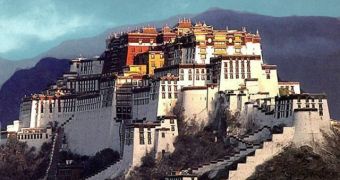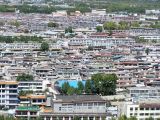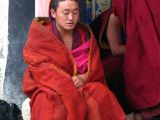The mysterious Tibet is experiencing a cultural shock between the Lamaist Buddhism, with its spiritual leader Dalai Lama, who fled in 1959, and the Chinese modernization, the emergent power which is changing Tibet as it had not made it since the People's Army put an end to the theocracy in 1951. The spirit against the matter.
In October 1950, the Chinese army crossed Yangtze river, advanced over the settlement of Chamdo and cut the return of the Tibetan forces. Chamdo, under Ngapoi Ngawang Jigme, was occupied. A Tibetan delegation, headed by Ngapoi, went to Beijing to negotiate an accord that would recognize both the liberation of Tibet and the right of the Tibetans to autogobernate. The compromise was signed in March, 23, 1951.
Buddhism penetrated Tibet during the 7th century coming from China and India, and was then when the king Songtsan Gambo unified the country, expanding its territory to the border of the Chinese empire led by the Tang dynasty.
The relations between Tibet and China - for which Tibet is part of it since the reign of Khubilai Khan (nephew of Genghis Khan) in the 13th century - started to deteriorate immediately. A revolt broke in the eastern Tibet in 1956, while news over the communist reforms triggered an exodus towards Lhasa, the capital. In March 1959, a rising emerged after the rumors that the Chinese authorities have decided to detain the current Dalai Lama, Tenzin Gyatso, the political and spiritual leader, recognized as the 14th reincarnation of Buddha (after a system introduced since the 17th century).
Dalai Lama fled, and in June, in Mussoorie (India) denounced the 1951 accord, considered to have been written under pressure.
But 4 decades later, the Chinese government has changed the iron hand, at least in public, with the silk gloves of the economical modernization. The carrot has replaced the bat, as the development could end with the Tibetans accepting the facts valid since 1951. The autonomous province, with 2.6 million Tibetans and three times bigger than France, has changed in the last 15 years. The mighty Potala palace, winter residence for Dalai Lama since 17th century, has remained approximately unchanged. But Lhasa has changed.
The buildings that have replaced the traditional Tibetan constructions have made the city look Chinese. Now Tibet scrapes the sky, and not only through its altitude. Already 50 % of Lhasa's 200,000 inhabitants is formed by Hans (the ethnic group of the Chinese proper). The Hans dominate the new Tibetan economy, which traditionally was based on agriculture. Still, the Tibetan edifices of the ancient quarter of Lhasa are now protected.
In 2002, Chinese authorities freed 6 Tibetan political prisoners and invited the elder brother of Dalai Lama, Gyalo Thondup to travel to Tibet for the first time since 1959.
Today, many Tibetan peasants have their own businesses, based on credits achieved from Bank of China, like small transport companies, or campings sheltering pilgrims that go to monasteries. Many sons of peasants now receive education and the monastery life is out of their option. These younger Tibetans can speak Chinese, while in most cases their parents do not. A lot of Tibetans work in tourism or traveling agencies.
Drepung ("rice mountain") monastery, built by the king Songtsan, is now inhabited by 500 permanent monks and 800 of part time. But it is still the pilgrimage site, at which daily arrive the believers after overcoming a tough slope, to deposit yak fat on the lamps that burn without a stop. Before 1959, 10,000 monks lived at Drepung. Between 1959 and 1980, the monastery was closed, as the monks were seen as Dalai Lama followers, and this way one generation was lost.
The monks work the land, breed yaks and gain also from entrance fees and shops. The sutras, the colorful fabric fetches with which Tibetans adorn their houses and temples, have special meanings: red is fire, white the clouds, green the water, blue the sky, and yellow the land. The joint represents the desire that earth and sky to be one.
The Tibetan culture is inseparable from religion. At the University of Tibet, the largest number of students are found at the Faculty of Tibetan Studies. Today, there are over 1,700 temples and religious centers, and 46,000 monks and nuns (there were 110,000 before 1959), of which over half belong to the sect of the Yellow Hat, that of Dalai Lama, the most important of the main schools. Before 1959, boys could be brought at monasteries at only 3 years old.
But in Tibet, there are many schools and sects. The Bon sect inherits the first Tibetan religion, a combination of beliefs in gods, demons, and spirits. The priests of this sect personify now a mix between this ancestral religion and Lamaist Buddhism. The Bon have a sacred mountain, Benri, near the border with India and Myanmar, where each 10 years the monks reunite to convoke the spirits of the Buddhas to make people happier. Currently, there are 2,000 living Buddhas in Tibet: some are reincarnations and others for wise.
Now, the economic change is reducing the influence of religion amongst young in the rural areas. Now, young can enter the monastery only after 18 years old.
In Tibet, 60-70 % of the members of the autonomous government and Communist Party are ethnically Tibetans, but at official encounters with foreign journalists, usually all the officials are Han, including the general secretary.
In 1995, Dalai Lama chose through a peculiar method involving a golden bottle Gedun Choekyi Nyima, 15 years old, as reincarnation of Pachen Lama, the second figure in the sect of the Yellow Hat. Beijing considered the election illegal and chose another, through the same method. Chinese authorities accused Dalai Lama of choosing as Panchen Lama the son of nationalist family.
The Beijing authorities cover 90 % of the Tibetan funds, the subsidies going even to the Lhasa beer. And the ambitious projects go to the railway that unites Tibet with the rest of China, a gigantic work of over 1,200 km (750 mi), at a cost of $ 2.4 billion. This ends the historical isolation of an area that fuels its mystery in its inaccessible character.
Many see in this the decisive blow, with the arrival of the Han, to the Tibetan language and culture.
By October 2007, the Chinese government is going to finish a "highway" on Mount Everest to ease the access of the Olympic torch on this course. The road will be 108 km (67 km) long and will cost about $ 20 millions, going to a camp located at over 5,200 m (17,060 ft). Mount Everest, the world's tallest mountain, is 8,848 m (29,035 feet) tall and named Chomolungma ("the mother goddess of the mountains") by Tibetans. The action is regarded by many as a method of reinforcing Chinese control.
Another project is the Shangri-La, the utopia of a paradise described by James Hilton in his 1933 novel "Lost horizon", a thematic park between Sichuan, Yunnan and Tibet.
The result of the contact between materialism and spiritual is shocking. The Tibetan women sell their trinkets at the doors of the Chinese karaokes. The main broadway in Lhasa has a supplement of light coming from neon announcements with nothing celestial on it and statues and monuments of Chinese influence, like the the winged horse of Zetang. At the foot of Potala is located the Dju Pin Dao discotheque, a posh location in Lhasa. Pool has turned in one of the preferred ways of spending time for the young.
The shepherds have changed their traditional saddles with powerful motors. The Samding Khansar edifice, facing Pentoc hotel in Lhasa was put down, through the desperation of the Tibetan Heritage Fund, expelled in 2000, and in its place a hotel and a restaurant were built. Barber's shops and bars, on the western models, are just covers for brothels for the numerous Chinese troops stationing in the province. Most of the prostitutes are Han, but the number of Tibetans is increasing.
Even the Dalai Lama gave up speaking about independence, and now, he only mentions large autonomy.

 14 DAY TRIAL //
14 DAY TRIAL // 

